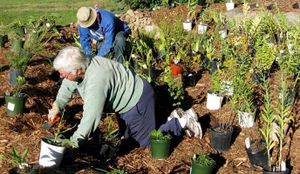
Difference between revisions of "Nomenclature and definitions for green infrastructure benefits"
m |
m |
||
| Line 4: | Line 4: | ||
==Nomenclature== | ==Nomenclature== | ||
| + | [[File:Marquette avenue 5.jpg|thumb|300px|alt=photo of trees on marquette Avenue|<font size=3>Trees, such as these on Marquette Avenue, Minneapolis Minnesota, [https://stormwater.pca.state.mn.us/index.php?title=Green_Infrastructure_benefits_of_tree_trenches_and_tree_boxes provide numerous environmental and social benefits]. Photo courtesy of the Kestrel Design Group, Inc.</font size>]] | ||
| + | [[File:Social capital.jpg|300px|thumb|alt=photo neighborhood garden|<font size=3>Social capital is building knowledge and skills through community interaction. An example is installing neighborhood gardens, which results in environmental benefits. Image: [https://masterwaterstewards.org/by-the-numbers/ Master Water Stewards]</font size>]] | ||
| + | |||
Green infrastructure benefits are often divided into three major categories - environmental, economic, and social. Because stormwater management is often linked to NPDES permits or local requirements, we added a fourth category called regulatory. Each of these can be further divided into additional benefits. The following nomenclature reflects what we have found in the literature and what is used in the Minnesota Stormwater Manual. | Green infrastructure benefits are often divided into three major categories - environmental, economic, and social. Because stormwater management is often linked to NPDES permits or local requirements, we added a fourth category called regulatory. Each of these can be further divided into additional benefits. The following nomenclature reflects what we have found in the literature and what is used in the Minnesota Stormwater Manual. | ||
*Environmental benefits | *Environmental benefits | ||
Revision as of 14:51, 27 December 2017
This site is currently undergoing revision. For more information, open this link.
This site is in development
This site is in development
There are a wide variety of green infrastructure (GI) benefits identified in the literature and no universal nomenclature or set of definitions. The nomenclature and definitions used in the Minnesota Stormwater Manual are summarized below.
Nomenclature

Trees, such as these on Marquette Avenue, Minneapolis Minnesota, provide numerous environmental and social benefits. Photo courtesy of the Kestrel Design Group, Inc.

Social capital is building knowledge and skills through community interaction. An example is installing neighborhood gardens, which results in environmental benefits. Image: Master Water Stewards
Green infrastructure benefits are often divided into three major categories - environmental, economic, and social. Because stormwater management is often linked to NPDES permits or local requirements, we added a fourth category called regulatory. Each of these can be further divided into additional benefits. The following nomenclature reflects what we have found in the literature and what is used in the Minnesota Stormwater Manual.
- Environmental benefits
- Improved water quality
- Pollutant removal
- Reduced salt use
- Water quantity benefits
- Reduced flooding and reduced peak flows
- Improved hydrology
- Groundwater recharge
- Improved air quality
- Ecological benefits
- Enhanced biodiversity
- Habitat improvement
- Climate benefits
- Resilience to climate change
- Reduced urban heat island effects
- Carbon sequestration
- Reduced greenhouse gas emissions
- Improved water quality
- Economic benefits
- Benefits to infrastructure
- Reduce water treatment needs
- Reduce grey infrastructure needs
- Reduced infrastructure costs
- Efficient or reduced resource use
- Increases available water supply
- Recycled materials
- Land regeneration
- Reduced energy demand
- Job creation
- Increased property values
- Benefits to infrastructure
- Social benefits
- Health
- Reduced crime
- Improved recreational opportunity
- Enhanced community livability and increased social capital
- Public education
- Enhanced aesthetics
- Reduced noise pollution
- Urban agriculture (food production)
- Health
- Regulatory benefits
- Meets regulatory requirements to implement green infrastructure practices
- Reduces pollutant loads as required in permits
Definitions
- Climate resilience. The ability of a system to absorb shock and still maintain function, continuing to thrive as stimuli evolve (Adger, 2006). Resilience is not simply about how robust a system is to disturbance, but how the system reacts to and creates opportunities from the disruption (Folke, 2006). Climate resilience includes but is not limited to the following potential climate changes.
- increased urban heat island effect
- increased or reduced precipitation
- increased rain intensity and magnitude of individual rain events
- increased length of dry periods
- Habitat improvement. Restoring, enhancing, or establishing physiographic, hydrological, or disturbance conditions necessary to establish or maintain native plant and animal communities, including periodic manipulations to maintain intended habitat conditions on completed project sites (16 U.S. Code § 3772). In contrast to many definitions in the literature, which focus on vegetation management to improve habitat for animals, this definition includes both plant and animal communities and any management activity that enhances these communities. For example, habitat improvement might include manipulating soil conditions to enhance specific vegetation that supports invertebrate populations. Indicators or indices may be used to assess habitat or ecosystem health and changes in health (see for example [1]).
- Social capital. Social capital is the stock of skills, knowledge, etc. that people bring to reoccurring, shared experiences. Social capital is developed through social networks or social connections. An example is neighborhood programs such as adopt-a-drain, leaf pick-ups, and rain barrel programs, which build neighborhood trust and communication while providing environmental benefits (Green et al., 2012).